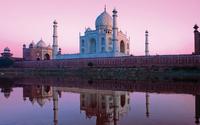Discover India's World Heritage Sites

From the Red Fort in Delhi to the Jungle Book-style forests of Kaziranga National Park and the timeless beauty of the Taj Mahal, India is home to an unparalleled wealth of natural and man-made treasures of such importance that nearly 30 have been designated as UNESCO World Heritage Sites.
These special places are the jewels in the crown of India's fascinating natural and cultural heritage - and now it's possible to visit seven of them in comfort and style during an 8-day journey aboard the ‘Indian Maharaja – Deccan Odyssey’, India’s first privately managed luxury train service.
Rich with the splendour of a bygone era, the Indian Maharaja transports passengers back to the days of the Raj on this thrilling overland journey between Delhi and Mumbai. The train's interior has been designed to evoke the opulence and grandeur that was once the preserve of India's regal emperors, with lavishly decorated interiors and a level of comfort and service that's second to none.
Starting in Mumbai amid the Gothic splendour of the Chhatrapati Shivaji Terminus (itself a World Heritage Site), the route passes through the beautiful and ever-changing scenery of Maharashtra and Rajasthan, traversing the very heartland of the Maharajas and Mughals and taking in no less than six additional World Heritage Sites along the way. The first of these is the famous Anjanta Caves, a 2,000-year-old series of hand-hewn underground chambers that are home to intricate reliefs and some incredibly well preserved murals. Like the prehistoric cave paintings in Lascaux, France, Ajanta's fabled murals are fragile and risk being damaged by the presence of too many people, so plans are afoot to restrict access and create a replica nearby for visitors to enjoy. The Indian Maharaja therefore offers an excellent opportunity for guests to experience this incredible site before it becomes off-limits.
Nearby lie the Ellora Caves, another World Heritage Site. This complex of 34 man-made caves was originally created as temples and monasteries that are known today for their incredible wealth of religious artworks encompassing the Buddhist, Hindu and Jain faiths. The most magnificent of all is the Kailasa Temple, a monumental structure of columns and chambers carved from a single, enormous rock.
Equally impressive is the Agra Fort (also known as the Red Fort of Agra), once an imperial city of the Mughal rulers and today widely considered to be the most important of India's historic forts. Completed in 1571, the massive and imposing fortress walls are constructed from smooth, red sandstone and enclose a series of towers, pavilions, palaces and mosques, many of which are adorned with beautiful and intricate carvings. Despite its grandeur, however, Agra Fort is overshadowed by its near neighbour, the Taj Mahal - surely the country's most iconic monument. Famously built in the mid-17th Century by the Mughal emperor Shah Jahan as a memorial to his late wife, Mumtaz Mahal, this stunning edifice of gleaming white marble is surely one of the world's most instantly recognisable buildings.
Another highlight of the journey is a visit to the deserted city of Fatehpur Sikri, once the capital of the Mughal Empire. Also known as the 'City of Victory', Fatehpur Sikri was built in the 16th Century by the Emperor Akbar to celebrate the birth of his son Jahangir. Replete with monuments, palaces and mosques, the city served as the capital for a period of just ten years before drought forced the inhabitants to abandon it and move elsewhere. Today the surprisingly well-preserved city provides an extraordinary place to visit and marvel at the architectural splendour of the Mughals.
The final World Heritage Site on the itinerary is the Qutab Minar, a towering minaret dating from the 12th Century that dominates the Delhi skyline. At 234 feet, Qutab Minar is the world's tallest free-standing minaret and one of the country's most visited monuments. Every epic journey aboard the Indian Maharaja incorporates a city tour of Delhi, which includes a stop at Qutab Minar along with other famous sites like Jama Masjid, one of the largest mosques in the whole of Asia.
In addition to encountering these seven wonders, a journey aboard the Indian Maharaja also includes a wealth of other amazing experiences, such as a visit to the Jaipur's Amber Fort; dinner in a Maharaja's palace at Udaipur; and a safari through the famed tiger sanctuary of Ranthambore National Park.
The cost of an eight night escorted group tour on the Indian Maharaja - Deccan Odyssey leads in at £2,925 per person with Great Railway Journeys. The holiday includes schedule flights from London Heathrow to Mumbai and Delhi to London Heathrow, 7 nights on board the Indian Maharaja Deccan Odyssey in a deluxe cabin, including all meals, 1 night hotel accommodation with breakfast and dinner in Delhi, all excursions as detailed in the itinerary, the services of a Tour Manager throughout, all transfers in India, flight taxes and charges. Excludes visas.
For more details go to: greatrail.com



